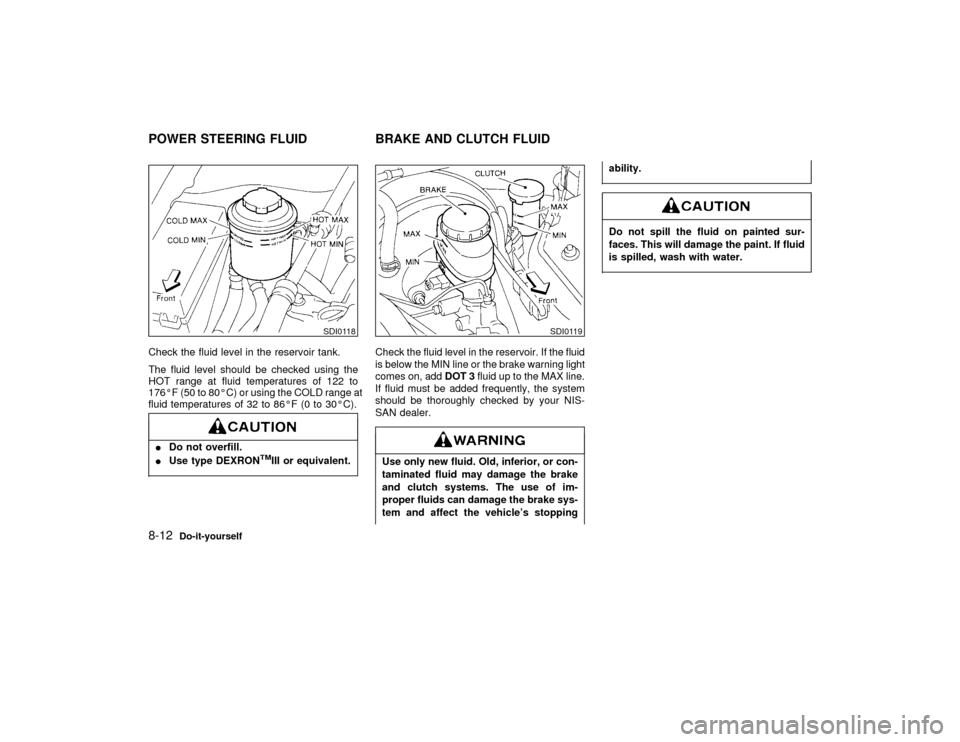1998 NISSAN MAXIMA power steering fluid
[x] Cancel search: power steering fluidPage 133 of 231

downshift to a lower gear before going down a
slope or long grade. Overheated brakes may
reduce braking performance and could result
in loss of vehicle control.IWhile driving on a slippery surface,
be careful when braking, accelerating
or downshifting. Abrupt braking or
accelerating could cause the wheels
to skid and result in an accident.
IIf the engine is not running or is
turned off while driving, the power
assist for the brakes will not work.
Braking will be harder.ANTI-LOCK BRAKE SYSTEM (ABS)
(if so equipped)The anti-lock brake system controls the brakes
at each wheel so the wheels will not lock when
braking abruptly or when braking on slippery
surfaces. The system detects the rotation
speed at each wheel and varies the brake fluid
pressure to prevent each wheel from locking
and sliding. By preventing wheel lockup, the
system helps the driver maintain steering con-
trol and helps to minimize swerving and spin-ning on slippery surfaces.
Using the systemDepress the brake pedal and hold it down.Do not pump the brake pedal. Doing so
may result in increased stopping
distances.Normal operationThe anti-lock brake system will not operate at
speeds below 3 to 6 MPH (5 to 10 km/h) to
completely stop the vehicle. (The speeds will
vary according to road conditions.) When the
anti-lock system senses that one or more
wheels are close to locking up, the actuator
(under the hood) rapidly applies and releases
hydraulic pressure (like pumping the brakes
very quickly). While the actuator is working,
you may feel a pulsation in the brake pedal
and hear a noise or vibration from the actuator
under the hood. This is normal and indicates
that the anti-lock system is working properly.
However, the pulsation may indicate that road
conditions are hazardous and extra care is
required while driving.
Self-test featureThe anti-lock brake system consists of elec-
tronic sensors, electric pumps, and hydraulic
solenoids controlled by a computer. The com-
puter has a built-in diagnostic feature that tests
the system each time you start the engine and
move the vehicle at a low speed in forward or
reverse. When the self-test occurs, you may
hear a clunk noise and/or feel a pulsation in
the brake pedal. This is normal and is not an
indication of any malfunction. If the computer
senses any malfunction, it switches the anti-
lock brake system OFF and turns on the ABS
warning light in the dashboard. The brake
system will then behave normally, but without
anti-lock assistance.
If the light comes on during the self check, or
while you are driving, you should take your
vehicle to your NISSAN dealer for repair at
your earliest convenience.
5-18
Starting and driving
Z
01.1.31/A32-D
X
Page 156 of 231

8 Do-it-yourselfMaintenance precautions .......................................... 8-2
Engine compartment check locations ....................... 8-4
Engine cooling system .............................................. 8-5
Engine oil .................................................................. 8-8
Automatic transaxle fluid ......................................... 8-10
Power steering fluid ................................................ 8-12
Brake and clutch fluid ............................................. 8-12
Window washer fluid ............................................... 8-13
Battery ..................................................................... 8-14
Drive belts ............................................................... 8-15
Spark plugs ............................................................. 8-16
Air cleaner ............................................................... 8-18
Windshield wiper blades ......................................... 8-18
Parking brake and brake pedal ............................... 8-20
Clutch pedal ............................................................ 8-21
Fuses....................................................................... 8-21
Lights ....................................................................... 8-24
Tires and wheels ..................................................... 8-31
Z
01.1.31/A32-D
X
Page 167 of 231

Check the fluid level in the reservoir tank.
The fluid level should be checked using the
HOT range at fluid temperatures of 122 to
176ÉF (50 to 80ÉC) or using the COLD range at
fluid temperatures of 32 to 86ÉF (0 to 30ÉC).IDo not overfill.
IUse type DEXRON
TMIII or equivalent.
Check the fluid level in the reservoir. If the fluid
is below the MIN line or the brake warning light
comes on, addDOT 3fluid up to the MAX line.
If fluid must be added frequently, the system
should be thoroughly checked by your NIS-
SAN dealer.Use only new fluid. Old, inferior, or con-
taminated fluid may damage the brake
and clutch systems. The use of im-
proper fluids can damage the brake sys-
tem and affect the vehicle's stoppingability.
Do not spill the fluid on painted sur-
faces. This will damage the paint. If fluid
is spilled, wash with water.
SDI0118
SDI0119
POWER STEERING FLUID BRAKE AND CLUTCH FLUID8-12
Do-it-yourself
Z
01.1.31/A32-D
X
Page 195 of 231

Seats:Check seat position controls such as
seat adjusters, seatback recliner, etc. to en-
sure they operate smoothly and that all latches
lock securely in every position. Check that the
head restraints move up and down smoothly
and that the locks (if equipped) hold securely
in all latched positions.
Seat belts:Check that all parts of the seat belt
system (for example, buckles, anchors, adjust-
ers and retractors) operate properly and
smoothly, and are installed securely. Check
the belt webbing for cuts, fraying, wear or
damage.
Accelerator pedal:Check the pedal for
smooth operation and make sure the pedal
does not catch or require uneven effort. Keep
the floor mats away from the pedal.
Clutch pedal*:Make sure the pedal operates
smoothly and check that it has the proper free
play.
Brakes:Check that the brakes do not pull the
vehicle to one side when applied.
Brake pedal and booster*:Check the pedal
for smooth operation and make sure it has the
proper distance under it when depressed fully.
Check the brake booster function. Be sure tokeep floor mats away from the pedal.
Parking brake*:Check that the lever has the
proper travel and make sure that the vehicle is
held securely on a fairly steep hill when only
the parking brake is applied.
Automatic transaxle P (Park) position
mechanism:Check that the brake pedal must
be depressed for the selector lever to be
moved from the P (Park) position. On a fairly
steep hill check that the vehicle is held se-
curely with the selector lever in the P (Park)
position without applying any brakes.
Under the hood and the vehicleThe maintenance items listed here should be
checked periodically (for example, each time
you check the engine oil or refuel).
Windshield washer fluid*:Check that there
is adequate fluid in the tank.
Engine coolant level*:Check the coolant
level when the engine is cold.
Radiator and hoses:Check the front of the
radiator and clean off any dirt, insects, leaves,
etc., that may have accumulated. Make sure
the hoses have no cracks, deformation, dete-
rioration or loose connections.Brake and clutch fluid levels*:Make sure
that the brake and clutch fluid levels are be-
tween the MAX and MIN lines on the reservoir.
Battery*:Check the fluid level in each cell. It
should be between the MAX and MIN lines.
Engine drive belts*:Make sure that no belt is
frayed, worn, cracked or oily.
Engine oil level*:Check the level on the
dipstick after parking the vehicle on a level
spot and turning off the engine. Be sure to wait
a few minutes to allow the oil to drain back into
the sump.
Power steering fluid level* and lines:Check
the level in the reservoir tank with the engine
off. Check the lines for proper attachment,
leaks, cracks, etc.
Automatic transaxle fluid level*:Check the
level on the dipstick after putting the selector
lever in P (Park) position with the engine idling.
Exhaust system:Make sure there are no
loose supports, cracks or holes. If the sound of
the exhaust seems unusual or there is a smell
of exhaust fumes, immediately locate the
trouble and correct it.
9-4
Maintenance
Z
01.1.31/A32-D
X
Page 205 of 231

The following are approximate capacities. The actual refill capacities may be a little
different. When refilling, follow the procedure instructed in the ª8. Do-it-yourselfº section
to determine the proper refill capacity.
Capacity (Approximate)
Recommended
specifications US
measureImp
measureLiter
Fuel 18-1/2 gal 15-3/8 gal 70Unleaded gasoline with an octane rating
of at least 91 AKI (RON 96)
Engine oil (Refill)
With oil filter 4-1/4 qt 3-1/2 qt 4.0IAPI SG or SH and Energy Conserving
II*1, *2
IAPI Certification Mark*1, *2 Without oil filter 3-7/8 qt 3-1/4 qt 3.7
Cooling system
With reservoir 9 qt 7-1/2 qt 8.5
Anti-freeze coolant
(Ethylene glycol base)
Reservoir 7/8 qt 3/4 qt 0.8
Manual transmission gear oilÐ Ð Ð API GL-4, Viscosity SAE 80W-90 only
Automatic transmission fluid
Refill to the proper oil level according
to the instructions in the ª8. Do-it-
yourselfº section.Nissan Matic ªDº (Continental U.S. and
Alaska) or Genuine Nissan Automatic
Transmission Fluid (Canada).*3
Power steering fluid Type DEXRON
TMIII or equivalent
Brake and clutch fluidGenuine Nissan Brake Fluid*4 or equiva-
lent DOT 3 (US FMVSS No. 116)
Multi-purpose greaseÐ Ð Ð NLGI No. 2 (Lithium soap base)
Air conditioning system refrigerantÐ Ð Ð HFC-134a (R-134a)
Air conditioning system lubricants Ð Ð ÐNissan A/C System Oil
Type S or exact equivalent
*1: For additional information, see later in ªCapacities and recommended fuel/lubricantsº for engine oil and oil filter recommendation.
*2: For additional information, see later in ªCapacities and recommended fuel/lubricantsº for recommended SAE viscosity number.
*3: Dexron
TMIII/Mercon
TMor equivalent may also be used. Outside the continental United States and Alaska contact a NISSAN dealer for
more information regarding suitable fluids, including recommended brand(s) of Dexron
TMIII/Mercon
TMautomatic transmission fluid.
*4: Available in mainland US through your NISSAN.
FUEL RECOMMENDATIONUnleaded premium gasoline with an octane
rating of at least 91 AKI (Anti-Knock Index)
number (Research octane number 96)
If unleaded premium gasoline is not avail-
able, unleaded regular gasoline with an
octane rating of at least 87 AKI (Research
octane number 91) can be used.
However, for maximum vehicle perfor-
mance, the use of unleaded premium gaso-
line is recommended.Using a fuel other than that specified
could adversely affect the emission con-
trol devices and systems, and could
also affect the warranty coverage.
Under no circumstances should a
leaded gasoline be used, since this will
damage the three-way catalyst.Reformulated gasolineSome fuel suppliers are now producing refor-
mulated gasolines. These gasolines are spe-
cially designed to reduce vehicle emissions.
CAPACITIES AND
RECOMMENDED
FUEL/LUBRICANTS10-2
Technical and consumer information
Z
01.1.31/A32-D
X
Page 225 of 231

Tire and wheel........................................... 8-33
Checking
Brake pedal ............................................... 8-20
Bulb ............................................................. 2-7
Engine coolant level .................................... 8-5
Engine oil level ............................................ 8-8
Parking brake ............................................ 8-20
Seat belt operation, Three-point ............... 1-21
Child restraint.................................................. 1-25
Installation on front seat ............................ 1-35
Installation on rear seat center ................. 1-27
Installation on rear seat outboard ............. 1-30
Precaution ................................................. 1-25
Top strap ................................................... 1-34
Child safety
Rear door lock ............................................. 3-4
Seat belt .................................................... 1-18
Chrome parts, Cleaning .................................... 7-4
Cigarette lighter and ashtray .......................... 2-19
Circuit breaker, Fusible link ............................ 8-22
Cleaner, Air ..................................................... 8-18
Cleaning
Exterior ........................................................ 7-2
Interior ......................................................... 7-4
Clock ............................................................... 2-25
Adjusting .................................................... 2-25
Clutch
Fluid ........................................................... 8-12
Pedal ......................................................... 8-21
Cold weather driving ....................................... 5-19
Compact disc (CD)
Player operation ........................................ 4-23
Player operation, with cassette player
type ............................................................ 4-23Console box .................................................... 2-22
Controls, Heater and manual air conditioner.... 4-3
Cooling system, Engine .................................... 8-5
Corrosion protection ......................................... 7-5
Cruise control.................................................. 5-12
Operation ................................................... 5-13
Cup holder ...................................................... 2-21
D
Defogger switch, Rear window and outside
mirror............................................................... 2-14
Dimensions and weights, Vehicle ................... 10-8
Door .................................................................. 3-2
Door open warning light ................................... 2-8
Drinking alcohol/drugs and driving ................... 5-3
Drive belt......................................................... 8-15
Driving
Cold weather ............................................. 5-19
On snow or ice .......................................... 5-20
Precaution ................................................... 5-2
The vehicle .................................................. 5-7
Drugs ................................................................ 5-3
EEconomy, Fuel ................................................ 5-15
Emission control
Information label ...................................... 10-10
System warranty...................................... 10-18
Engine
Block heater .............................................. 5-21
Compartment check location....................... 8-4
Coolant heater ........................................... 5-21Coolant temperature gauge ........................ 2-5
Cooling system ............................................ 8-5
Oil ................................................................ 8-8
Oil and oil filter recommendation .............. 10-4
Overheat ...................................................... 6-9
Serial number .......................................... 10-10
Specifications ............................................ 10-7
Exhaust gas (Carbon monoxide) ...................... 5-2
Explanation of maintenance items .......... 9-3, 9-10
Exterior and interior light, Replacement ......... 8-26
F
F.M.V.S.S. certification label......................... 10-10
Fastening the seat belt
Three-point ................................................ 1-20
Two-point ................................................... 1-23
Filling, Fuel filler lid ......................................... 3-11
Filter, Air ......................................................... 8-18
Flasher switch, Hazard warning ..................... 2-17
Flat tire .............................................................. 6-2
Floor mats, Cleaning ........................................ 7-4
Fluid
Automatic transaxle ................................... 8-10
Brake ......................................................... 8-12
Engine ......................................................... 8-8
Power steering .......................................... 8-12
Window washer ......................................... 8-13
Fog light switch ............................................... 2-16
Front
Fog light switch ......................................... 2-16
Interior light................................................ 2-26
Manual seat adjustment .............................. 1-2
Power seat adjustment................................ 1-4
Z
01.1.31/A32-D
X
11-2
Page 227 of 231

M
Maintenance
General ................................................ 9-2, 9-3
Item .................................................... 9-3, 9-10
Periodic........................................................ 9-5
Precaution ................................................... 8-2
Seat belt .................................................... 1-25
Manual
Front seat adjustment ................................. 1-2
Operation, Air conditioner ......................... 4-11
Transmission, Driving ................................ 5-10
Meter
And gauge ................................................... 2-3
Speedometer and odometer ....................... 2-4
Tachometer ................................................. 2-4
Mirror............................................................... 3-13
Inside ......................................................... 3-13
Outside ...................................................... 3-14
Multi-remote control system.............................. 3-5
NNew vehicle, Break-in ..................................... 5-14
OOdometer .......................................................... 2-4
Oil
Automatic transaxle ................................... 8-10
Brake ......................................................... 8-12
Engine ......................................................... 8-8
Filter recommendation............................... 10-4
Power steering .......................................... 8-12Opener operation
Fuel filler lid ............................................... 3-11
Trunk lid..................................................... 3-10
Operating tips, Automatic air
conditioner ........................................ 4-5, 4-6, 4-11
Operation, Cruise control ................................ 5-13
Outside mirror ................................................. 3-14
Overheat ........................................................... 6-9
P
Parking
Brake ......................................................... 5-12
Brake and brake pedal .............................. 8-20
Parking/parking on hills .................................. 5-16
Pedal
Brake ......................................................... 8-20
Clutch ........................................................ 8-21
Periodic maintenance ....................................... 9-5
Personal light .................................................. 2-26
Power
Front seat adjustment ................................. 1-4
Seat operating tips ...................................... 1-4
Steering ..................................................... 5-17
Steering fluid ............................................. 8-12
Window ...................................................... 2-22
Precaution
Maintenance ................................................ 8-2
On child restraint ....................................... 1-25
On cruise control ....................................... 5-13
On seat belt usage .................................... 1-17
On supplemental restraint system .............. 1-7
When starting and driving ........................... 5-2
Pregnant women, Seat belt ............................ 1-19Push starting ..................................................... 6-9
R
Radio............................................................... 4-12
With cassette player .................................. 4-13
With cassette player and compact disc (CD)
player ......................................................... 4-19
Readiness for inspection/maintenance (I/M) test
(US only) ....................................................... 10-18
Rear
Door lock, Child safety ................................ 3-4
Window and outside mirror defogger
switch......................................................... 2-14
Recommended
Fuel/lubricant ............................................. 10-2
SAE viscosity number ............................... 10-6
Recovery, Freeing a stuck vehicle ................. 6-12
Refrigerant, air conditioning ............................ 10-6
Registering your vehicle in another country ... 10-9
Release
Hood ............................................................ 3-9
Trunk lid....................................................... 3-9
Remote keyless entry, Multi-remote
control ............................................................... 3-5
Reporting safety defects (US only)............... 10-18
Restraint, Child ............................................... 1-25
Rollover ............................................................. 5-3
Rotation, Tire .................................................. 8-33
SSafety
Belt ............................................................ 1-17
Z
01.1.31/A32-D
X
11-4